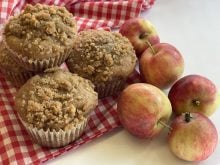May is a busy month. As soon as the snow goes it seems like everything needs attention.
Perennials want to get rid of last year’s dead leaves, the grass needs raking to remove winter debris, the garden needs to be tilled and new seeds planted, the dead branches need to be removed from shrubs, roses and trees, the windows sure need washing as does the rest of the house, and the list goes on. There is no one to complain to as everyone else is out in the field seeding. But of course grandkids’ ball games, track and field, dance and other events are more important and so the list at home has trouble getting done. That’s just the way it should be.
Read Also

Vintage power on display at Saskatchewan tractor pull
At the Ag in Motion farm show held earlier this year near Langham, Sask., a vintage tractor pull event drew pretty significant crowds of show goers, who were mostly farmers.
Ice cream treat
My 10-year-old granddaughter Sara likes to watch cooking programs on TV and sometimes tries out the recipes she sees. One was this ice cream dessert that would be great for parties to celebrate the end of the school year. It’s simple for kids to make and to share with friends or family. Sara has shared it with her family on a few occasions including her windup hockey party.
For 10 servings you will need:
Rolo chocolate bar (has 10 pieces) Pail of ice cream
Dozen cookies
10 plastic or glass serving dishes
Crush your favourite kind of cookies into crumbs by placing in a food processor and chopping, or by placing in a sturdy bag and rolling with a rolling pin.
Scoop out serving sized balls from an ice cream pail. Insert a piece of Rolo chocolate bar in the middle of each ice cream ball. Roll in the cookie crumbs and place in serving cups or dishes. Freeze until ready to eat.
Emmie Oddie website
We have mentioned this website in our column before, but want to remind you of it. It is a good resource at www.homefamily.net.
The website was established in recognition of Emmie Ducie Oddie, who for nearly five decades used her home economics training to answer questions from readers of her column in the Western Producer. The website is maintained by the Association of Saskatchewan Home Economists.
Homefamily.net provides factual, well-researched information on home economics topics to prairie household managers, consumers, teachers, students and home economists on such topics as money management, food and nutrition, housing, clothing and textiles, the family and consumer issues.
Are pickles junk food?
Pickles are not junk food, but they’re not a substitute for raw or cooked vegetables. Pickling means steeping a food in a preservative, usually brine or vinegar. Often the food is a cucumber but nearly anything can be turned into a pickle, such as green tomatoes, green beans, cauliflower, peppers, onions or carrots. Before refrigeration and canning, pickled vegetables were a necessity of life.
Any processing destroys some vitamins, particularly water-soluble ones like B and C. The real trouble with pickles is that the sour or dill varieties are high in sodium. A five ounce (140 gram) sour pickle has only 16 calories but 1,650 milligrams of sodium, which is 70 percent of the maximum recommended daily intake. There are low-salt versions, but they don’t taste like pickles. Sweet pickles are lower in salt, but higher in calories.
Eat pickles in small quantities, with other foods, as condiments or as occasional treats.
Source: University of California, Berkeley Newsletter, May 2007.
Is it worth it to home garden?
Dear TEAM: Many years ago there was an article on the cost savings of growing a garden versus buying frozen vegetables. Is it possible for you to do the same comparison with today’s prices? Nothing comes close to homegrown for flavour, but I’d love to have some numbers to back up all my hard work. – R.P., Kindersley, Sask.
Dear R.P.: There are so many variables, it is hard to answer your question. One is whether it is a wet or dry year. Do you haul your water and how far, or do you use town water? How many seeds will germinate from a package? What is the value of your time? What vegetables are you growing? Carrots have up to 2,000 seeds in a $2 package while corn has 200 or 300 seeds in a $4 package. Also, 10 carrots will likely cost less to buy than 10 cobs of corn. Are you paying for fertilizer or compost? Do you pay for your garden to be rototilled?
For fun I tried pricing corn.
This example is for a corn patch of 50 plants that would produce at least 50 cobs. I’m assuming this would be only part of the whole garden.
Costs:
To till = $2
Seeds = 90 cents
Gas to haul water = $4.80 (three waterings)
Fertilizer or compost = $2
Weeding and picking = $15 (11/2 hours)
Total = $24.70
Cost to buy 50 fresh cobs of corn would be approximately $20.
If you don’t count your time, because you enjoy the outdoor exercise, it would be a cost saver to grow your own corn.
For frozen corn, processing to freeze it would add the extra costs of time, freezer bags and electricity for blanching and freezing.
What we are missing here is the enjoyment of watching the plants grow, of nurturing them along and the wonderful flavour of “fresh from the garden” produce.
Is it worth the hard work? I’m one who would like to think so.
Freezing foods
- Does freezing destroy nutrients?
If fruits and vegetables are frozen quickly, packed in airtight containers and kept frozen during shipping and marketing, they will retain almost all of their nutrients. Any kind of processing, whether it is freezing or cooking, destroys some vitamins. Fresh foods also lose nutrients, especially if not properly handled, or if they sit in the market or your refrigerator too long. If vegetables are harvested and quick-frozen immediately on site, they may have more vitamins than fresh ones transported across the continent. Frozen foods may not taste as good as fresh, but the difference in nutrition is slight.
When freezing produce from our garden, the same is true. Freeze soon after picking and pack in airtight containers to retain nutritive content.
- Does freezing destroy fibre?
No, freezing does not destroy or degrade fibre as some people claim.
- Does freezing kill bacteria in food?
Freezing does not destroy bacteria in foods but puts them in a dormant state. Frozen foods will not spoil if kept frozen. When thawed, the bacteria will start to multiply. Thawing foods, especially meat, in the refrigerator will keep the food below 40 F (4 C) and prevent bacteria from quickly multiplying.
Use thawed foods right away and cook until the same amount of doneness as fresh foods.
Don’t buy packages with ice crystals or other signs of melting and refreezing. Buy frozen food just before checking out and take it straight home to the freezer.
Chocolate banana coffee cake
This recipe is being passed around our community, a sign that it is good. I tried it and agree.
Use a nine x 13 inch (22 x 33 cm) cake pan that is two inches (five cm) deep.
Mix together and set aside:
1/2 cup brown sugar 125 mL
1 teaspoon cinnamon 5 mL
Have ready:
1 package chocolate chips 270 g
Batter:
1 cup butter or soft margarine 250 mL
2 cups sugar 500 mL
2 eggs
1 teaspoon vanilla 5 mL
21/2 cups mashed banana 625 mL
1 cup sour cream 250 mL
3 cups flour 750 mL
2 teaspoons baking powder 10 mL
2 teaspoons baking soda 10 mL
Cream butter and sugar. Beat in eggs and vanilla, then mix in bananas and sour cream. Sift together flour, baking powder and baking soda. Add flour mixture to creamed mixture.
Pour half of the batter into the greased pan. Top with half of the sugar and cinnamon mixture and half of the chocolate chips. Pour on the rest of the batter and top with the rest of the sugar and cinnamon mixture and the rest of the chocolate chips.
Bake at 350 F (180 C) for one hour. Test for doneness.
Good news about napping
A new study by American and Greek researchers shows that people who take at least three daytime naps a week, lasting 30 minutes or longer, cut their risk of dying from a heart attack by 37 percent.
The study followed 23,681 originally healthy men and women in Greece for more than six years. Slightly more than half the study group (13,400) took regular midday naps – a mark of the siesta’s popularity in Mediterranean societies. The nappers’ death rate was about two-thirds the rate of Greeks, who stayed awake all day.
Regular siestas apparently lower stress. Stress is frequently associated with heart disease and shows up in a person’s blood pressure, heart rate, hormones and sugar and cholesterol levels. Also, people who recover quickly from stress are better off than those whose stress levels remain high all day. Therefore, if you can take a midday nap, do so.
Alma Copeland is a home economist from Elrose, Sask., and one of four columnists comprising Team
Resources. Send correspondence in care of this newspaper, Box 2500, Saskatoon, Sask., S7K 2C4 or contact them at team@producer.com.
















